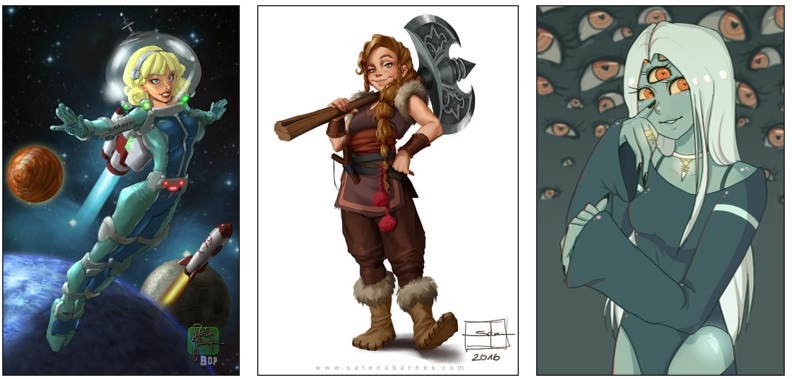Meet Cosmarina the Space Girl, Brutalina the Barbarian Girl, and Stacey X the Alien Girl, whom I brought as these pictures and character sheets to a public-meet-the-gamers event here in town, at a center for filmmaking and viewing called Cnema.
Here is what I do. First, I set out the Space Rat play-materials in an inviting way. When people join me, I say, “Unusually for a role-playing game, this is competitive.” The response is always positive. When I specify that the characters aren’t, but the players are, people get very curious.
The scenario uses this picture, which I said is the capital city of the Planetary Utopian Union, and for which I turned the mild satire of Sweden from the Spelens Hus Space Rat game up to 11.

Immediate attention at the start is commanded by the nominal antagonist, who had a couple of names, eventually settling on Bengt Bengtsson, a notorious mutant galactic outlaw. They know he’s in the city, that he’s rumored to be at the platform in the middle of the map (a “jetpack and hovercraft parking center”), and that Jack is present and trying to catch him. I tell them outright that Jack’s basically an idiot and they know they better do something, whether to save Jack, to catch Bengt, or to save the PUU, whatever they individually may want.
- Bengt has a Good Body, Good Mind, Excellent Spunk, and Excellent Combat, with the Attribute “Dissident allies everywhere” and Gear “Full of scary gadgets” – both of the latter are phrased more generally than ordinarily allowed for characters, but then again, he has only one of each.
- Everyone calls him a hideous mutant; he is a strikingly handsome man … because his native species is horrible and hideous, so as a mutant … well, OK, it’s a stupid joke, but I like it.
At the location, Bengt has set up a scary machine attached to the parliament and economic management building (the shiny thing in the middle of the map), with blinking green and black lights. If anyone troubles to figure out what it will do, it will crash the economy. Futhermore, Jack is indeed there, being punched in the nose by Bengt and staggering around at the edge of the platform.
But most of the trouble arises before the femme babes get there, from the overly-helpful and self-appreciative city services and security, described in my notes as Zealous ethical law enforcement.
- It’s Good in all its scores (of course) and has the attributes “Ideology” and “Extensive communications.”
The aforementioned trouble begins with the first thing I ask them, “You’re not from around here, everything seems convenient but requires confusing personal numbers and codes, so how do you get there?” [tapping the spot on the map] They’re in separate places at the edge of the city. Who gets there, how, and first, or whatever else they may be involved in, is the matter for the first resolutions in play.
Once they see the dice in action and some Luck spending, and possibly one or two gain an Attention Star, then I explain the Luck testing procedures, and from there, all ascends into chaos, in the very best sense.
- In a couple of the sessions, a squad of floating pods appeared, with a manager and a megaphone, to provide helpful counseling as clearly you have suffered a social and psychological shock … lie down in the pod and interact with our counseling AI app for optimal readjustment … plus helpful fellows with net-shooters in case you are so unfortunately disoriented as to try to avoid being helped.
People have been asking me for years to name viable Step On Up role-playing designs, and I often have to say “well, if you play it that way,” regarding Tunnels & Trolls, for example. It’s hard to get past the hobby cultural stereotype that this purpose-of-play is composed of whining, cheating, and bullying, all of which are actually its opposite. Nor is it dedicated necessarily to improvement; arguably, if the “reward” is useful in the fiction, then it’s probably missing the point. Very few titles really satisfy the query – dedicated on-purpose design – and the best are The Great Ork Gods and Space Rat. We should investigate more, e.g., I’ve played Blood Red Gods and Beast Hunters, but not enough to be confident in my thoughts about them.
However. I must step on and squish an extremely prevalent outlook which has plagued my discussion of play-purposes for all these years. If you think a game text can give it to you, or worse, can show your problematic friends, then you’re already tumbling out of the discussion. When I talk about purpose-coherent game design, I’m talking about by and for people who already do it. Saying, “But how do I enjoy competitive play? Oh, Space Rat will show me!” is thoroughly doomed.


3 responses to “Setting it out there”
Your comment about play purposes and them not being able to be taught through text or explanation resonates with my own experience. Let me know if this matches your understanding: from what I’ve see and understood, it’s something that emerges from a certain instance of play, and is mostly driven by people interacting and emoting, and specifically what they interact and emote about. It’s not a property of a certain game text (although a text might be consciously designed for it).
Regarding your comment on T&T, I’m still not too familiar with the game. If you “play it that way”, does a similar phenomenon as Space Rat occur, where players are competing, but characters are not? Are there any posts on the matter on this site that I might read?
I haven’t addressed purpose in playing T&T in the posts, partly because I think online discussion hasn’t served the whole topic well for over two decades, so why bother. I’ll try a little bit here.
It’s useful first to think about the role of the GM in both Space Rat and The Great Ork Gods. It’s partly about necessary setup and asymmetrical knowledge, greatly about simply keeping up the adversity, and partly about knowing and designating “when it’s over” on the basis of diegetic content. These jobs are the same for Tunnels & Trolls.
However, Space Rat and The Great Ork Gods are both interplayer-competitive, whereas Tunnels & Trolls isn’t particularly or necessarily so – one may or may not care about who’s been losing characters more than whom, for example. The Step On Up that I’ve experienced with the game is more in line with the textual presentation, that losing (specifically character death) is a momentary phenomenon, a condition if you will, pertaining to one’s personal performance. You’re mainly competing against yourself-so-far (improving, not improving) in context of the diegetic adversity, “against the GM” in that sense only, with some up-and-down group dynamics that are familiar to any team sport player.
Therefore (1) the T&T GM must be actively quite adverse, a “worthy challenger” if you will, which isn’t necessary in Space Rat or The Great Ork Gods, because the real adversity in those games comes from interplayer procedures; and (2) the T&T players are not competing among themselves, or if at all, not so much or in any formal way. T&T as procedure/purpose is also more adjustable to however the group/table wants to do it.
In accord with my comment here, I think the phrases “and emoting” and “and emote” are adding nothing to your point, and may provide the wrongful message that playing on purpose is a matter of people making a lot of noise and grimaces and high-fiving and all that stuff. When those things happen, fine, whatever; if they don’t, nothing is lost regarding the topic you’re working with.